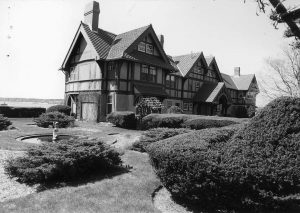In 1998, the Sippican Historical Society commissioned an architectural survey of Marion’s historic homes and buildings. The survey was funded one-half by the Sippican Historical Society and one-half by the Massachusetts Historical Commission. Due to the limits of funding, not all of the historic buildings were surveyed, but over 100 were catalogued and photographed. The results of the survey are in digital form on the Massachusetts Historical Commission’s website and in four binders in the Sippican Historical Society’s office (and at the Marion Town Clerk’s office).
Marion (Old Rochester) is one of the oldest towns in the United States, and the Sippican Historical Society maintains an extensive collection of documentation on its historic buildings. The Sippican Historical Society will preview one building a week so that the residents of Marion can understand more about its unique historical architecture.
This installment features 125 Allen’s Point. Until as late as 1890, Allen’s Point was a remote, undeveloped part of Marion. By the mid-19th century, Allen’s Point was part of Henry D. and Stephen Allen’s holdings. Their homes were located on the west side of Point Road, near its intersection with Cross Neck Road, but they no longer exist. The Allens were farmers. Henry D. Allen was one of Marion’s first three selectmen in 1852-1854. At some point between 1855 and 1879, the Allens sold Allen’s Point, the West Drive area, and other tracts south of Point Road to George Delano. The lovely summer estate of Edward M. Clark at 125 Allen’s Point Road was designed by the Boston architectural firm of Coolidge and Carlson. It was built in the early 1900s. Among Coolidge’s best-known works were Byerly and Randolph Halls (at Radcliffe and Harvard respectively), dormitories at Wellesley College, and the Bates College Library in Lewiston, Maine. This home is of the finest example of Tudor Revival domestic architecture in Marion. Outbuildings include a stable, garden house, and boat house. Edward M. Clark commissioned the Boston landscape architect Arthur A. Shurcliff, a student of Frederick Law Olmsted, to design the south garden and the estate’s grounds. His best-known landscape work was in Colonial Williamsburg. Clark sold the property to Richard Hoyt, whose daughter, Virginia Peirson, inherited the property from her parents.
